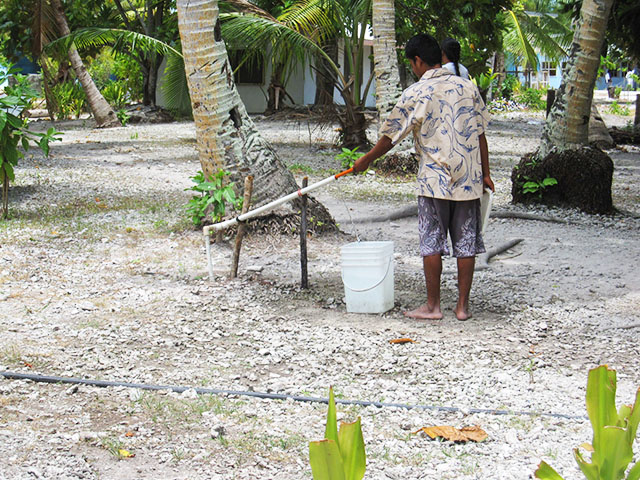
Climate Change Resilience
The atoll of Tamana, in Southern Kiribati, is the origin of a pump design that has helped thousands of communities in the Pacific island nation. Now known across Kiribati and internationally as the Tamana Pump, the design is a simple hand powered system that can greatly reduce water contamination by allowing pumping from closed wells.

"It is essential to have a pump rather than use a bucket or a tin container to bring water. This common system of using a container on a string contaminates the well water" said Hon. Waysang Kumkee, Minister for Public Works and Utility (pictured below).

On the remote outer islands of Kiribati, maintenance and spare parts might be many months away when the next supply ship or qualified technician arrives. But the Tamana pump has no electronics or complicated mechanical parts, allowing it to be repaired more easily if a system breaks down. Furthermore, it is a system that is well known enough that many community members are capable of repairing them themselves.
"If we can have one water tank to service a small community with a manual pump and try to avoid having an electrical pump, because our problem is maintenance and servicing, no one can actually look after it if it breaks. A manual pump, or gravity feed system, is the best long term solution" said the Hon. Waysang Kumkee.
SPREP has undertaken assessments on Abaiang atoll which included water testing that confirmed superior water quality at sites with Tamana pump systems. There is great potential for improved water supply solutions on the atoll as 92% of households there reported using hand held buckets to obtain water from their wells. Sites will now be identified where the new Tamama pumps can be installed.
The Government of Kiribati is leading a 'whole-of-island' integrated approach to climate change adaptation and disaster risk management. Abaiang atoll is the first site for this approach. Within the integrated approach, SPREP and the Kiribati Ministry of Public Works and Utilities, with project funding from USAID, are aiming to improve water resources capacity in Abaiang.

Photo: Carlo Iacovino
"It is essential to have a pump rather than use a bucket or a tin container to bring water. This common system of using a container on a string contaminates the well water" said Hon. Waysang Kumkee, Minister for Public Works and Utility (pictured below).

Photo: Azarel Mariner
On the remote outer islands of Kiribati, maintenance and spare parts might be many months away when the next supply ship or qualified technician arrives. But the Tamana pump has no electronics or complicated mechanical parts, allowing it to be repaired more easily if a system breaks down. Furthermore, it is a system that is well known enough that many community members are capable of repairing them themselves.
"If we can have one water tank to service a small community with a manual pump and try to avoid having an electrical pump, because our problem is maintenance and servicing, no one can actually look after it if it breaks. A manual pump, or gravity feed system, is the best long term solution" said the Hon. Waysang Kumkee.
SPREP has undertaken assessments on Abaiang atoll which included water testing that confirmed superior water quality at sites with Tamana pump systems. There is great potential for improved water supply solutions on the atoll as 92% of households there reported using hand held buckets to obtain water from their wells. Sites will now be identified where the new Tamama pumps can be installed.
The Government of Kiribati is leading a 'whole-of-island' integrated approach to climate change adaptation and disaster risk management. Abaiang atoll is the first site for this approach. Within the integrated approach, SPREP and the Kiribati Ministry of Public Works and Utilities, with project funding from USAID, are aiming to improve water resources capacity in Abaiang.